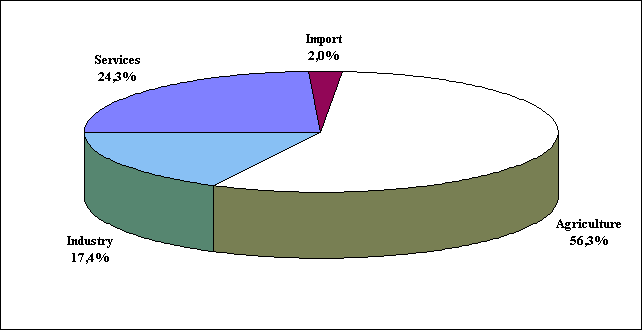The 1993 population of the Lao PDR is estimated at 4.5 million, and is projected to grow at 2.6 % per year. Population density remains one of the lowest in the region, at 19 persons per square kilometer.
Vientiane municipality has a population of about 503,000 and a modest population density of 128 per square kilometer. The provinces with the biggest number of inhabitants are Savannakhet (692,000) and Champasack (490,000) in the south and Luang Prabang (365,000) in the north. Apart from Vientiane, the major urban centers are the cities of Savannakhet and Pakse in the south with populations of 109,000 and 55,000, respectively and Luang Prabang in the north with 69,000 inhabitants.
Two thirds of the population live in rural areas of the 17 provinces, including Vientiane Municipality, and one special region comprising the Lao PDR. The population lives in 685,230 households with an average size of 6.7 members in 11,935 small villages (ban) located in 129 districts (muong). The population of Oudomsay province decreased substantially in 1992 as four of its districts were administratively detached : two were attached to the province of Bokeo, whose population correspondedly increased, and two were reorganized into a Special Region comprising a small population of 74,000 people.
The population of the Lao PDR is ethnically diverse. Up to 68 ethnic groups- have been identified inhabiting the country, which can be roughly categorized into : 1) the Lao Loum, who occupy the lowland plains and the Mekong river valley, and constitute some two thirds of the total population, 2) the Lao Theung, who occupy the mountain slopes comprising about 22 % of the population, and who are thought to have been the first inhabitants of Laos in the pre-historic era, and 3) the Lao Soung, who occupy the high mountain tops over 1,000 meters constituting about 10 % of the total population, and who carry indigenous linguistic traditions in the remote and highly mobile settlements. Particular emphasis is being placed on finding ways to more fully integrate the ethnic groups into the economic and social life of the country.
SOCIAL CHARACTERISTICS
The are great regional disparities in access to education. An estimate for adult literacy is 50 % for all adults, 65 % for men, and 35 % for women. Significant efforts were made to build up primary education after 1975, but although the ratio of schools to students increased markedly, particularly at the primary school level, the quality of education did not keep pace with the expansion of the system. This is reflected in high drop out rates of over 60 % from primary education, in which 880 % of the children enroll. It is recognized that more public resources must be devoted to teachers' training, their salaries, and teaching materials.
Improvements in health and sanitation, with emphasis on the well - being of mothers and children, are vitally needed. The crude birth rate is 45 per 1000, infant mortality rates range from an estimated 104 to' 135 per 1000 live births depending on the region, and the under - five mortality rate is 156 per 1000 live births life expectancy is estimated at only 50,9 years. Half of the children under 5 years old are affected by malnutrition and most of the population lack access to basic health and sanitation, birth spacing, and nutritional services. Diarrhoeal, respiratory, and intestinal diseases are widespread, and particularly virulent strains of malaria are prevalent in some areas.
ECONOMIC CHARACTERISTICS
The annual per capita income, estimated to be about US$290 in 1993, understates living standards in the Lao PDR because the non-monetized segment of the economy is not represented in the income data. This applies particularly to the agricultural sector, where subsistence fanning is the main occupation, and rice is the staple food crop.
Agriculture is the principal economic sector 'in the Lao PDR, accounting for 56% of total value added in 1993 and covering a wide range of activities from subsistence production to agriculture related industries. About 80 % of the population is engaged in agriculture, broadly defined to include livestock, fisheries and forestry.
It is estimated that approximately 649,000 hectares of land are under cultivation, of which 539,000 hectares or 83% are devoted to rice cultivation. Sixty five percent of the country's rice is grow 'in the lowlands, of which only 3.7% are irrigated. The remaining thirty five percent of rice production is in the uplands, where 60 % of the population do not produce enough to cover their own needs and lack rice for about ' 3 months per year, during which time they eat maize, cassava, taro, and other rice substitutes. Families dependent on upland rice production, as well as in the lowest terraces, are particularly vulnerable to the vagaries of the weather.
Other crops, including coffee, maize, starchy roots, soybeans, mungbeans, peanuts, tobacco, cotton, sugar cane, tea, and a variety of others are planted to the remaining 17 % of cultivated land area.
Sizeable livestock holdings include buffalo and cattle, as well as pigs, sheep, goats, poultry, and other animals.
The industrial and service sectors of the economy currently account for about 17 and 24%, respectively, of Gross Domestic Product. Under the New Economic Mechanism, adopted in 1986, there has been a rapid expansion in the output of the industrial sector, particularly manufacturing. Consequently, the share of agriculture to GDP declined somewhat from 59% in 1992 to 56% in 1993. Nonetheless, the economy remains predominantly agricultural in nature.

DEVELOPMENT POTENTIALS AND CONSTRAINTS
The physical and Socio-economic characteristics of the Lao PDR set out in the previous paragraphs have given rise to the following development potentials and constraints :